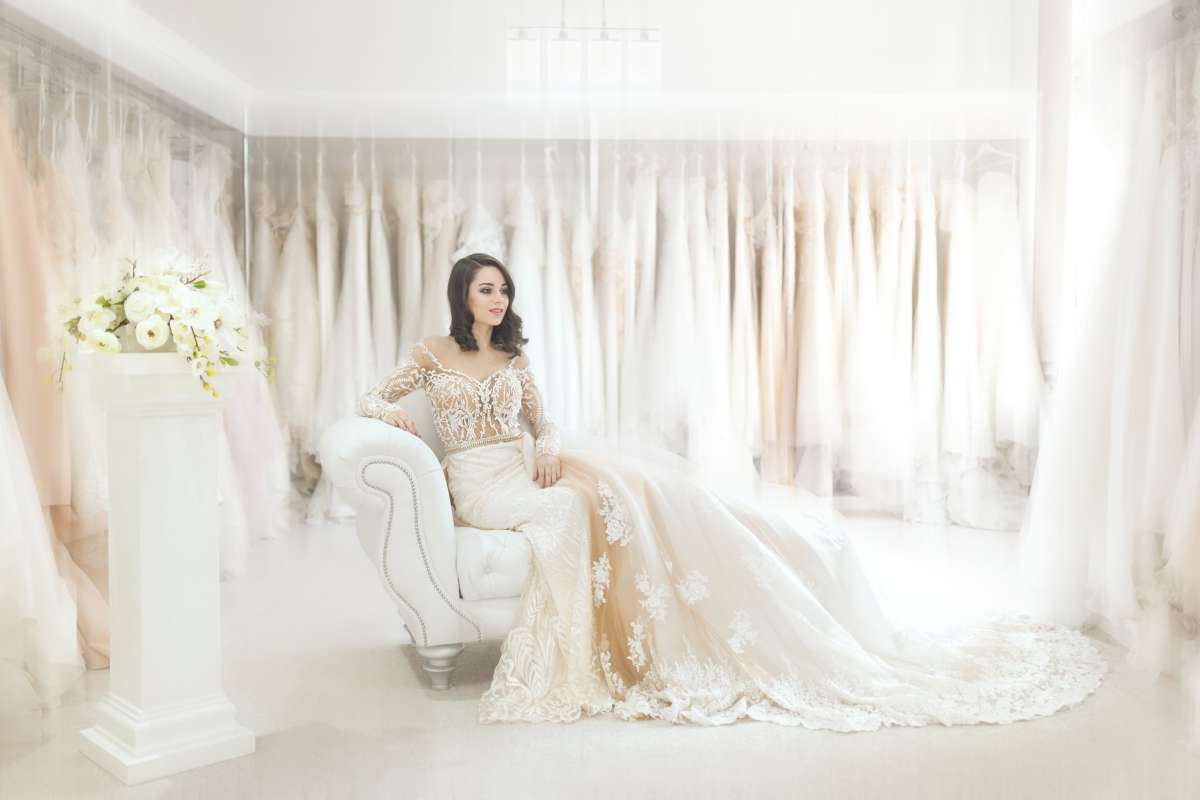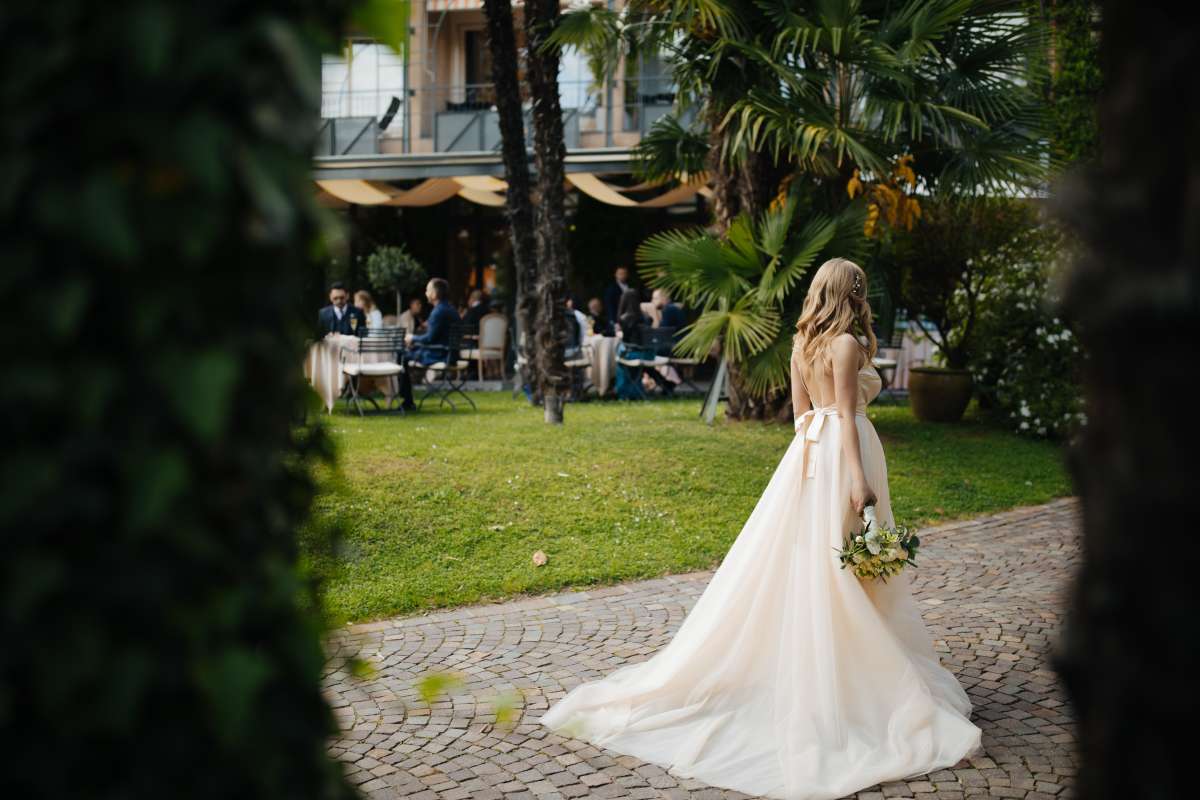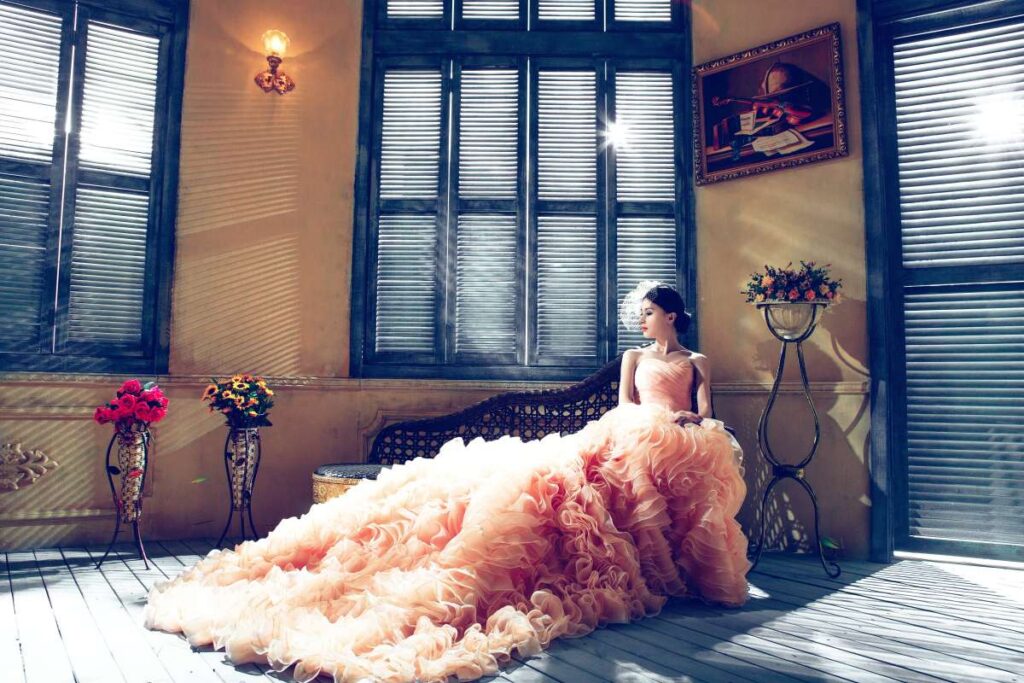"Is it possible to colour wedding gowns?" It's a natural enquiry for a bride to have.
Dyeing your wedding dress is an option for a number of reasons. Perhaps you like letting your imagination run wild and are not a fan of the classic white. If you've always wanted to feel like a princess, maybe a shade that's just a little bit pinker than pink is the answer you've been looking for. However, is it possible to colour a white wedding gown? Why, yes! Your bridal dress is fair game for a little DIY dyeing.
It's true that if you don't do it correctly, you could end up ruining the dress, but that's not quite as bad as it sounds!
You should probably hire a pro to dye your wedding dress, but it's easier than you might think.
Dying a wedding dress is a viable option for a variety of reasons.
Perhaps you have an itch to get creative, are looking to save money on your big day, or want to choose a shade of green that you haven't seen anywhere else.
Perhaps your big day has come and gone, and you're looking for a solution to give your dress a fresh new appearance that won't immediately label you as a bride.
Dying your wedding dress, for whatever reason, is a lot less of a big deal than you might think.

The ability to produce a magnificent, one-of-a-kind gown that will leave you swimming in compliments is well within your reach provided you have the appropriate materials, are meticulous during the process, and don't cut any corners. Vogue Ballroom has proven itself to be an iconic wedding venue and function centre in Melbourne. Book today so you don’t miss out.
There are a few possibilities, so let's talk about how to dye your wedding dress.
Can You Dye Your Wedding Dress?

Wedding dresses can be dyed, either by the bride herself using a bucket soak or dip process, or by taking the dress to a professional.
The latter is what you should do!
Dresses are costly, and it's usually not a smart idea to dye one yourself if you don't know what you're doing.
I mean, why would you want to colour a dress in the first place? Perhaps you've finally found the ideal silhouette and design for your ideal gown.
Still, white isn't necessarily your best option. Possibly it's excessively bright and causes visual fatigue.
Fortunately, you may dye your wedding dress an unconventional shade that is still pastel-like but stands out more.
It's also possible that you're considering a very light or very dark hue. Since it is your special day, you may choose any colour you like to wear.
To change its colour, all you need is a reliable dye and your own personal preference. Here are a couple of options for dyeing your wedding dress.
Bath in a Bucket
A full, uniform coat of colour can be achieved by soaking the dress in a pail of dye. The dress needs to be soaked for the specified period in the dye solution.
In order to prevent splotchy areas where the colour buildup is heavier in certain places than others, it is necessary to move the garment about a bit while dying it this manner.
This is why it's often recommended to hire a professional instead of attempting it yourself.
Use of a Dyed-in-the-Wool Process
Dip dying the clothing will give you that ombre look. This will add lovely depth to the hem of your garment by gradually increasing the saturation of the colour from its lightest point at the top to its darkest point at the hem.
The colour will gradually disappear as the fading progresses. Using a wide range of hues can be complicated, so it may be prudent to enlist expert assistance.
Learn the steps on a scrap of fabric that closely matches the dress's material. Learning how the material responds to the dye requires some trial and error.
Insight into the duration and quantity of dye required to obtain the desired colour can be gained.
Decide on a colour that won't wash out the dress's fabric. Many wedding dresses are composed entirely of fragile materials and can only be cleaned by a professional dry cleaner.
If you want to dye your wedding dress, you need to find one that won't ruin the fabric.
Silk charmeuse can be dyed with Procion, but dry-clean-only materials shouldn't be dyed with RIT.
Hot water from the shower can be used to fill a huge bucket.
You may also use your sink, but keep in mind that dye might ruin the finish on some containers, so it's easier to just use something disposable.
Include some gasoline oil. Gasolene oil is used to achieve more uniform colouring. A half teaspoon per gallon of water is the recommended dose.
To the water, add the colour. Make use of the information you gathered in the first step, or the provided instructions. Then, use the wooden paint stick to stir the dye solution.
Mix in the salt and vinegar. Vinegar is an effective, non-hazardous silk fixer. It strengthens the dye's bond with the cloth, allowing the Procion dye (and other fibre-reactive dyes) to stay put.
While soda ash is commonly used on silk, baking soda can also be used as a fixer.
In order to fix one gallon of water, you will need one ounce of fixer. For successful dyeing, salt is used to increase the fabric's receptivity to the colour. To every gallon of water, dissolve one cup of salt.
Submerge the dress into the dye up to the desired starting point. Dip-gradated dying's effect is typically seen moving from light to dark. Wait a few minutes before removing the fabric from the dye.
Once the colour has changed, slowly remove an inch or two of the dress every few minutes.
Every five minutes, cut out larger pieces of the clothing if you want a more dramatic colour difference.
Each time you take off a section of the dress, you can add a stronger dye solution to the water to increase the colour.
The bridal gown should be washed in cool water. After removing the hem of the dress from the dye bath, give it a last rinsing in cold water until the water is clear.
Use warm water for washing the dress. To dry the garments after washing, simply hang them.
Advice on Dying Your Wedding Gown
Breathe deeply, because you can learn everything you need to know about dying your wedding dress without completely trashing your office.
Materials
- Coloring fabric with a chemical solution
- Garbage disposal fluid
- To remove stains, use either salt or white vinegar.
- Two measuring implements: a cup and a teaspoon
- Spoon or skewer made of an impermeable material
- A plastic shield to prevent damage to surfaces
- Wearing latex gloves and goggles
- Fixative (optional, but prefered) (optional, but recommended)
Figure Out Your Next Move
Since not all colours perform the same, you should make a decision on your next steps as soon as possible. Aiming for a rich, darker shade like inky black or royal blue is far different from putting a wash of colour over white garments or doing a dip-dye.
To create a deeper colour, you'll need to use extra dye. The garment's base colour should be taken into account as well; if your wedding gown isn't white, you'll likely need to use a colour remover first.
Determine the Type of Fabric You Are Using
Care labels should be consulted to determine the sort of cloth used in an item, as different materials react to dye in different ways. Get your dress weighed; you'll need the data in a minute.
The cellulose fibres of linen, silk, and rayon respond nicely to a reactive fibre dye. An acid dye works best on protein filaments like those present in silk, wool, angora, and cashmere.
Dispersed dyes for synthetic fibres and blends including polyester, nylon, acrylic, and acetate will produce the best results for many fabrics. In any case, it differs from artificial to synthetic, so you'll want to check around first.
Need help planning your wedding? Check out our list of Wedding Event Planners here.
Organize Your Office Space
Put down some plastic sheeting to shield your work area and gather your supplies.
If you possess or have access to a clothes washer that is suitable for the job, then you can complete the process in a single step. For the objectives of this tutorial, we will instead demonstrate the process using a sink or bucket.
Try to conduct the task in a well-lit area, preferably with a sink in stainless steel or a big plastic container like a pail or a storage bin. As long as it's big enough to fit your clothing and the sink or bathtub isn't made of ceramic. This is because pottery is porous and will soak up the colour almost as well as your clothes.
Get Your Dress Prewashed
Lather up with some quality soap Put your dress into a basin of hot soapy water to remove dirt and restore its original sheen. When you're done washing and rinsing, dump out the liquid soap and fill your jar with hot water so your dress will float freely, but hold off on adding it for now.
The Art of Dye-Mixing
Put on some rubber gloves, and then measure out the dye depending on the garment's dry weight. If you want a more concentrated colour, like a deep magenta or emerald green, double the recommended ratio.
Before using liquid dyes in a bath, it is recommended to add a tablespoon of soap and shake the bottle vigorously. Powder should then be mixed in around two glasses of hot water using the same method.
The addition of a cup of salt to cotton, rayon, ramie, or linen can help, while a little more than 3/4 cup of white vinegar will do the trick for nylon, silk, or wool.
Determine the Accuracy of a Swatch
Find a small, hidden scrap of the clothing and dye it before you do the whole thing. To do this, you need inspect the interior for seams and remove a tiny bit from one of them.
You should try it
Adding the moist garments to the dye concentration and stirring regularly for ten minutes can help prevent splotching.
After then, depending on the material, the dress can remain submerged for a further hour or two. When you've reached the desired shade, remove the dress from the bath and let the excess water to drain.
Thoughts on a Fixative
Afterward, you can use a fixative to prevent the paint from chipping or bleeding. The fixative option is off the table if you're not interested.
Rit recommends using four tablespoons of fixative and three litres of water for every kilogram of cloth, so fill up your basin or bucket with hot water and measure out the fixative accordingly. Stir gently and frequently for twenty minutes, as in the previous step.
Please Drain and Dry
Wash your garment in warm water with a gentle detergent, then rinse it thoroughly in cool water until the water runs clear.
At long last, it's over! For the price of dye and adhesives and less than ten easy steps, you can make a one-of-a-kind, beautifully dyed wedding gown.
How can you make adjustments to your dress so that it better reflects who you are?

Ombre Design
The potential dangers posed by the dyes, however, this task is better left to the professionals. It would be a shame if your lovely outfit was creased. If you want to wear a vibrant hue on your wedding dress, experts say it's best to keep it minimal and wear it at the hemline. It adds visual appeal to the dress and protects the wearer from soiling their feet.
Tie-Dye Effects
There has been a recent uptick in the popularity of tie-dye styles for wedding dresses. This is a unique spin on the classic white wedding dress and a fun way to express your wedding theme. This means that you can put your own stamp on your special day if you're the creative sort. To get the desired tie-dye effect, it is not necessary to completely colour in the dress. The outfit would look beautiful with just the lower part tie-dyed.
Boho Vibe
A dip-dyed wedding dress is the perfect finishing touch for a bohemian-themed wedding. This is the best approach to make a cheap dress unique and stylish.
A Veil Must Always Be Worn.
Even though all eyes should be on your beautiful gown, you may draw even more attention to it by matching your veil's colour to the pink or purple you're adding to the hem of your wedding dress. Think of your ensemble as a whole; you may even incorporate the flowers into your hair to bring out the colours.
While there are various methods to include colour into your wardrobe, we do not recommend dying a luxury wedding dress (unless you have a large budget in case the dying process goes wrong!).
To guarantee that the dye is applied uniformly throughout the fabric, we recommend having a professional colour your dress. The wedding location is also crucial, as are the photographs taken during the ceremony. Your wedding dress's colour should pop against the breathtaking setting, so plan accordingly.
How Do I Find a Place to Have My Wedding Gown Dyed?
If you want to change the colour of your wedding dress, the finest venues to do so are select bridal boutiques and high-end costume shops. But first and foremost, you should make sure they are trustworthy publications.
Getting assistance to have your wedding dress coloured is not something to be ashamed about. You should do so. You certainly don't want to mess up the lovely outfit, so shipping it out is a good idea. Yes, but where do you mail it?
Multiple wedding dress stores should be contacted as this service is growing in demand. A few alternates are also available.
Proposal Store
Some bridal boutiques may offer this service, but not all.
There's probably a catch, like needing to buy their clothing so you can dye it, though. It's possible that this is due to concerns about legal responsibility. By doing so, they will prevent damage to someone else's dress.
Luxury Dressing Rooms
No, we're not talking about a haunted house supply shop. Instead, they sell fake jewelery and clothing at "costume stores."
This shop may be a good place to look for theatre costumes, as it serves both performers and productions. Designers who can sew jewellery, dye clothing, and make changes are typically on hand, making this a viable choice.
Depending on the circumstances, this could be a preferable alternative to traditional bridal salons.
In a nutshell, today is your day.
Although wearing a white wedding dress has been customary for centuries, times are a-changin'. One's wedding dress need not be white if one so chooses. This is why, in recent times, it has become more common to dye one's dress.
You might want to go bold and different, or you might prefer the concept of an off-white pastel shade with a touch of colour to coordinate with the rest of your wedding's decor.
However, no one has the right to dictate your wardrobe choices. Even still, the price may influence your emotions. You have the dress, you have the shoes? But what about the Wedding Jewellery? Check out our list of Wedding Jewellery Shops here.
It can easily increase the expense of the wedding by a few hundred dollars. You can do it yourself, but you should be competent in the task. The procedure is straightforward, although mistakes can be made. This is a once-in-a-lifetime opportunity, as this will be your wedding dress. You can distribute it to costume shops or bridal boutiques. It's expensive, but it guarantees a job well done.
Conclusion
Dying a wedding dress is a viable option for a variety of reasons. If you don't have time or money to hire a professional, DIY dyeing is an option. Vogue Ballroom in Melbourne is the venue to book if you're looking for a unique wedding outfit. Wedding dresses can be dyed, either by the bride herself using a bucket soak or dip process. It's often recommended to hire a professional instead of attempting it yourself. Using a wide range of hues can be complicated, so it may be prudent to enlist expert assistance.
Content Summary:
- It's a natural enquiry for a bride to have.
- Dyeing your wedding dress is an option for a number of reasons.
- Perhaps you like letting your imagination run wild and are not a fan of the classic white.
- If you've always wanted to feel like a princess, maybe a shade that's just a little bit pinker than pink is the answer you've been looking for.
- However, is it possible to colour a white wedding gown?
- Your bridal dress is fair game for a little DIY dyeing.
- It's true that if you don't do it correctly, you could end up ruining the dress, but that's not quite as bad as it sounds!
- You should probably hire a pro to dye your wedding dress, but it's easier than you might think.
- Dying a wedding dress is a viable option for a variety of reasons.
- Perhaps you have an itch to get creative, are looking to save money on your big day, or want to choose a shade of green that you haven't seen anywhere else.
- Perhaps your big day has come and gone, and you're looking for a solution to give your dress a fresh new appearance that won't immediately label you as a bride.
- Dying your wedding dress, for whatever reason, is a lot less of a big deal than you might think.
- Vogue Ballroom has proven itself to be an iconic wedding venue and function centre in Melbourne.
- Book today so you don't miss out.
- The ability to produce a magnificent, one-of-a-kind gown that will leave you swimming in compliments is well within your reach provided you have the appropriate materials, are meticulous during the process, and don't cut any corners.
- There are a few possibilities, so let's talk about how to dye your wedding dress.
- Can You Dye Your Wedding Dress?
- Wedding dresses can be dyed, either by the bride herself using a bucket soak or dip process, or by taking the dress to a professional.
- The latter is what you should do!
- Dresses are costly, and it's usually not a smart idea to dye one yourself if you don't know what you're doing.
- Perhaps you've finally found the ideal silhouette and design for your ideal gown.
- Still, white isn't necessarily your best option.
- Possibly it's excessively bright and causes visual fatigue.
- Fortunately, you may dye your wedding dress an unconventional shade that is still pastel-like but stands out more.
- It's also possible that you're considering a very light or very dark hue.
- Since it is your special day, you may choose any colour you like to wear.
- To change its colour, all you need is a reliable dye and your own personal preference.
- Here are a couple of options for dyeing your wedding dress.
- A full, uniform coat of colour can be achieved by soaking the dress in a pail of dye.
- The dress needs to be soaked for the specified period in the dye solution.
- In order to prevent splotchy areas where the colour buildup is heavier in certain places than others, it is necessary to move the garment about a bit while dying it this manner.
- This is why it's often recommended to hire a professional instead of attempting it yourself.
- Dip dying the clothing will give you that ombre look.
- This will add lovely depth to the hem of your garment by gradually increasing the saturation of the colour from its lightest point at the top to its darkest point at the hem.
- The colour will gradually disappear as the fading progresses.
- Using a wide range of hues can be complicated, so it may be prudent to enlist expert assistance.
- Learn the steps on a scrap of fabric that closely matches the dress's material.
- Learning how the material responds to the dye requires some trial and error
FAQs About Wedding Dresses
Dying of the gown starts at $350 and can go up depending on material content, or any complex/customized dye requests. Individual separates start at $150 for tops and $275 for skirts.
The good news is there is hope for your yellowed wedding dress. Advancements in technology along with new breakthroughs in delicate fiber cleaning formulations have made now a great time to consider having your old, yellowed wedding dress whitened and restored.
Dying it is only possible if your dress is made of natural fibers ie silk, satin, rayon etc. You can dye Synthetic fibers but they do not dye at all well especeially if you want a really vivid color.
For lighter shades, we suggest 10 to 20 minutes. For 100% polyester and polyester blends, at least 30 minutes is needed for the dye to be absorbed into the fabric, even if fabric appears to have reached the desired shade in less time.


